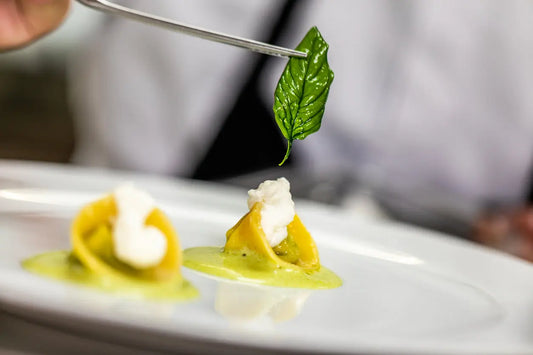The Chef of the Ratana restaurant in Milan, Cesare Battisti arrives at Congusto Institute to take lesson to the students of the professional chef course . The young future professionals attended and participated in an operational manner in a lesson dedicated to traditional Milanese cuisine. Among Battisti's objectives, the desire to convey the importance of the teachings of the past prevails. The Milanese chef has always paid particular attention to the seasonality of raw materials and the theme of sustainability, updating traditional recipes. « For a contemporary chef, preparing traditional dishes means adapting to modern times, because traditional cuisine must be innovated, dishes must be served in a contemporary way to modern palates, which are totally different from those of the past ».
Bringing traditional cuisine into the future to update it

« Knowing traditional cuisine - explains Battisti - is critical. To innovate a dish and evolve, you need to know how it was made. If you don't know who you are, you don't know where you're going. Phrase probably overused, but it gives a good idea. What was once innovation then became tradition once delivered into our hands. Today, we have the duty to innovate once again to carry it forward into the future ." Anyone who wants to be a chef by profession must necessarily start from the basics and learn how to make typical dishes of traditional cuisine. Only later will it be possible to innovate them. Training therefore plays a decisive role along the path that leads a student to work in the sector as a true professional. But, what are the main elements that chef Cesare Battisti covers during his lessons at the Congusto Institute? « The aspects to grasp during one of my lessons – continues the Ratanà chef - it's definitely the love and a certain sensitivity we put into making a dish. Skills to possess, develop and carry forward in your professional career. Cooking is about creating intimate relationships with your guests and even colleagues. Cooking something that another person eats is not only an act of love, but also an act of social responsibility ."
Respect for the culinary culture of the past

Chef Cesare Battisti decided to create a series of dishes of clear Lombard inspiration. Starting from a great classic like tripe. A recipe based on centopelli and borlotti beans. Then he put mondeghili, classic recycled meatballs, on the menu. While, for the dishes dedicated to vegetables, he proposed the preparation of roast pumpkin. A dish created to enhance the taste of seasonal vegetables, which includes cubed almonds among the ingredients: peeled almonds, almond butter and almond milk. Chef Battisti was among the first protagonists to clear and ennoble the use of the fifth quarter in the kitchen, relegated for a long time to just a waste.
Energy sustainability in the kitchen

The chef Battisti then underlined how catering is classified as a sector with extensive use of energy, therefore it is necessary to trigger a virtuous circle starting from training. « It is clear therefore - the chef specified - that it is necessary for restaurateurs to find energetically sustainable solutions, both for an environmental and economic issue. This implies not only the use of equipment with higher energy classes, the purchase of which has enjoyed strong incentives in recent years, but also a training of restaurant staff, who must be educated to behave responsibly to avoid waste and losses. The choice of your suppliers also plays a fundamental role in this area. Our sector must gradually move towards favoring producers who use energetically sustainable practices, we are therefore talking about hydroponic crops, agrophotovoltaic systems, use of sustainable bioenergy, to name a few. Finally, it is essential to educate and raise awareness of the final consumer, in our case the customers who sit in our restaurant, so that they are informed about what they are eating and where it comes from, to direct them towards an increasingly informed choice .
This is an important opportunity for the young students of the school comparison with great professionals in the sector, who bring daily experience in the kitchen into the classroom, an additional element that is part of the training path that leads to entry into the world of work of increasingly aware young generations.
By the editorial team



